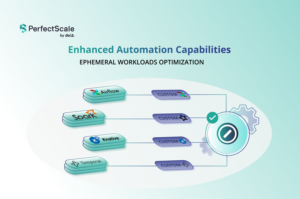Engineers are not opposed to reducing cloud costs — they just don’t have time for the extra effort. The solution may lie in greater automation.
According to the 2021 State of FinOps Report, the biggest challenge facing FinOps teams is getting engineers and developers to adopt better cloud cost optimization. Engineers face multiple optimization challenges simultaneously – everything from performance and reliability to security and development speed. Having to balance cloud costs with all of these is something they could do without.
In this article, we discuss the challenge of involving cloud engineers actively in cloud cost optimization and some measures that may make it easier for them to manage costs.
FinOps teams struggle to get buy-in from engineers
IDC predicts that in 2022 companies will invest in public cloud cost management with the aim of halving cloud waste, which they believe accounts for at least 20% of their public cloud spend. This is a tall order for FinOps teams, particularly because engineers engaged in the work that generates that cost have priorities other than cloud spend to consider.
Engineers appreciate the ease with which they can spin up new instances of cloud resources, but it is understandable if they forget about running resources because they are leveraging the speed of development the cloud facilitates. A simple mistake such as inadvertently leaving a large number of unnecessary instances running could cost a company tens of thousands of dollars. Even without such disasters, cloud bills can quickly mount without proper vigilance. But with engineers focused on things like backlogs and features, cost considerations are not top of mind.
The key to managing cloud costs is making it easy for everybody involved in incurring them to ensure the spend is justified. It’s not about simply slashing costs: Maintaining a laser focus on lowering spend could prevent the organization from reaping the business benefits of agility and speed that the cloud can bring. What is required is a commitment to reducing and ultimately eliminating wasteful spending.
Methods to encourage cost optimization
When the monthly cost of your cloud use starts to eclipse the revenue growth it is designed to nurture, your organization has a problem. Before you can hope to control your cloud spending, you need to develop a deep understanding of how your team uses cloud resources and how planned architecture and infrastructure changes will affect future spending. Armed with this knowledge, you are better equipped to embed a sense of accountability among your team members.
Create visibility into cost drivers
Hosted and cloud-based services are predicted to reach 26% of total IT budgets in 2022, but information technology executives lack the transparency they need to plan accurately for cloud infrastructure costs. It’s impossible to control what you cannot see, but as your cloud infrastructure becomes more complex, it becomes more difficult to get an accurate picture of costs. The first step to enlisting the help of engineers in eliminating cloud waste is to analyze the data and attribute costs to the appropriate teams.
This was the approach taken by Airbnb, which built a consumption attribution model to enable developers to see just how big a problem cloud overspend had become — and give them the information they needed to make decisions about cost and other business drivers that would help them keep their spending within specific limits.
Visibility into what was driving spend encouraged engineers to make changes to architecture design that would cut costs and also highlight cost headwinds. A centralized cost-efficiency team could use the cost attribution mechanism to gain full visibility into the complete Airbnb ecosystem as they looked for meaningful cost-savings opportunities.
Avoid inflicting policies from above
Instilling top-down control on cloud spend undermines the value proposition of cloud: the ability to build and launch products quickly and efficiently. Dictating policy on resource provisioning through multiple management layers slows time to market and results in over-provisioning of resources. A better approach is to collaborate on cloud budgets, basing decisions on shared information and feedback gathered from all relevant parties.
When engineers are allowed to request the resources they need with no unreasonable barriers, organizations create opportunities for faster, better business outcomes and a more engaged engineer culture. Savings recommendations are reviewed by other engineers, who are best placed to approve or reject them because they can assess whether they can reasonably cover the workloads involved. In this way, organizations develop a model for agreeing on the best cost optimization policies while also focusing on such key initiatives as stability, reliability and revenue generation.
Cultivate a practice of accountability
FinOps should allocate responsibility for cloud spend to the teams that incur it. These teams need to have the right tools and resources to generate spending forecasts, monitor their spending and identify opportunities for cost optimization.
Teams should have proper training in an operating model that transfers full life-cycle responsibility for a product or service to the engineering teams. This kind of accountability involves setting clear expectations for delivery teams and outlining the consequences of cost overruns.
IT chargeback and IT showback are two policies for associating the costs of IT hardware, software, cloud services or shared services with the business unit that uses them. With chargebacks, departments are billed for the number of technological resources they use, whereas showbacks inform departments of their usage without charging them.
Not everyone will be happy with this new shift in accountability, but it could make engineers think more holistically about their cloud usage and secure significant cost savings in the long term.
Consider gamification
Some companies rely on outdated accounting practices that reduce budgets if cost centers don’t spend all their allocations within a given year. This does not motivate a prudent approach to spending and is more likely to result in a flurry of spending at the end of the financial year.
An alternative approach is to find out what motivates your engineers and reward them with appropriate incentives. Some companies employ gamification methods, displaying leaderboards with each engineering team’s cloud spend, calling out results in review meetings and generally broadcasting each team’s performance to encourage healthy competition. The teams with the most meaningful improvement over time receive rewards ranging from pizza to vacations.
However, the danger with this approach is that engineers may become so focused on reducing cloud costs, eventually they will spend nothing – and that is not an effective optimization strategy. Companies considering gamification as a tool to encourage cloud cost optimization should gamify metrics other than reduced cloud spending, such as increased margins attributable to cloud use.
Automate the process
Engineers are not naturally wasteful. But neither are they motivated to manage their spending carefully because their focus is on delivering business solutions that leverage the speed and flexibility of the cloud.
However, if it is made easier for them to manage waste, they will embrace the opportunity. Automation could play a role in helping them to identify problems that are leading to unnecessary spending and resolving those issues as soon as they occur. A product like DoiT’s Flexsave can be a useful part of the solution, automating cloud cost optimization in a way that allows organizations to realize maximum savings.
Achieving results
FinOps teams on a mission to recruit engineers to their cloud cost optimization campaigns should not get disillusioned early on: There is no fail-safe route to better cloud cost management. To make those important marginal gains, you need to adopt a collaborative approach, embrace automation and iterate as you go. Strong support from management is also crucial.
As cloud’s share of every organization’s technology spend continues to expand, these and other FinOps practices will soon become mainstream. Ultimately, every engineer will know how to manage a cloud bill.



